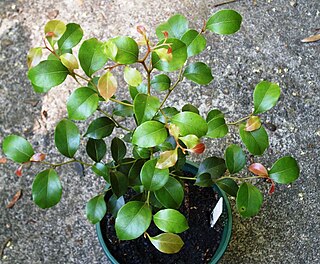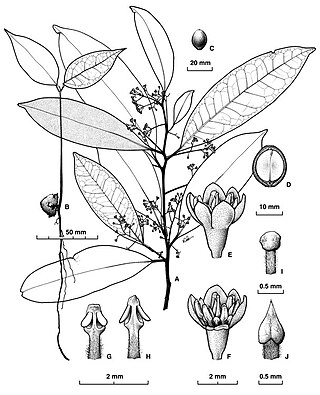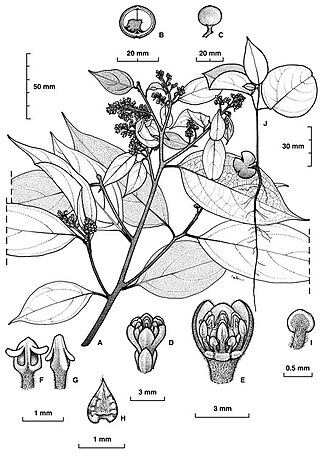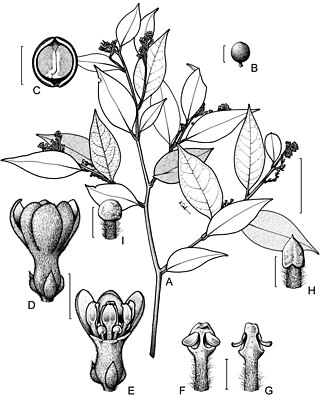
Cryptocarya williwilliana, commonly known as small-leaved laurel, is a species of flowering plant in the laurel family and is endemic to near Kempsey in northern New South Wales. It is a tree or shrub with egg-shaped or lance-shaped leaves, the flowers creamy-green and perfumed, and the fruit a spherical to elliptic, black drupe.

Cryptocarya microneura, commonly known as murrogun, murrogun laurel or brown jack, is a species of flowering plant in the laurel family and is endemic to eastern Australia. It is a rainforest tree with lance-shaped to elliptic leaves, the flowers cream-coloured and tube-shaped but not perfumed, and the fruit a spherical to elliptic black drupe.

Cryptocarya foveolata, commonly known as small-leaved laurel, small-leaved cryptocarya or mountain walnut, is a species of flowering plant in the family Lauraceae and is endemic to eastern Australia. It is a medium-sized to large tree with elliptic to egg-shaped leaves, cream coloured, perfumed, tube-shaped flowers, and spherical black drupes.

Cryptocarya triplinervis, commonly known as blackbutt, three-veined cryptocarya, brown laurel or three-veined laurel, is a species of flowering plant in the family Lauraceae and is endemic to eastern Australia. It is a tree with egg-shaped to elliptic or lance-shaped leaves, cream-coloured to pale green flowers, and elliptic black drupes.

Cryptocarya bidwillii, commonly known as yellow laurel, is a species of flowering plant in the laurel family and is endemic to eastern Australia. Its leaves are lance-shaped to elliptic, the flowers creamy-white and tube-shaped, and the fruit an elliptic black drupe.

Cryptocarya floydii, commonly known as Glenugie laurel or gorge laurel is a species of flowering plant in the family Lauraceae and is endemic to eastern Australia. It is a tree with lance-shaped leaves, pale green tube-shaped flowers, and spherical black drupes.

Cryptocarya onoprienkoana, commonly known as rose maple, southern maple, rose walnut or pigeonberry ash is a species of flowering plant in the family Lauraceae and is endemic to Queensland. It is a tree with lance-shaped to elliptic leaves, creamy-green, perfumed flowers, and elliptical black to bluish-black drupes.

Cryptocarya corrugata, commonly known as corduroy laurel, oak walnut, acidwood or bull's breath, is a species of flowering plant in the laurel family and is endemic to north Queensland. It is a tree with egg-shaped to elliptic leaves, the flowers creamy-green, slightly perfumed and tube-shaped, and the fruit a spherical black to bluish-black drupe.

Cryptocarya vulgaris commonly known as northern laurel, is a species of flowering plant in the family Lauraceae and is endemic to north Queensland. It is a tree with elliptic to oblong or lance-shaped leaves, creamy yellow and pale green, perfumed flowers, and spherical black drupes.

Cryptocarya cunninghamii, commonly known as Cunningham's laurel or coconut laurel, is a species of flowering plant in the laurel family and is endemic to northern Australia. It is a tree with oblong to elliptic leaves, the flowers creamy-green and tube-shaped, and the fruit a spherical black to purplish-blackdrupe.

Cryptocarya bamagana, commonly known as Bamaga walnut, is a tree in the laurel family and is endemic to Cape York Peninsula. Its leaves are lance-shaped to elliptic or egg-shaped, the flowers cream-coloured and tube-shaped, and the fruit a spherical black drupe.

Cryptocarya bellendenkerana is a tree in the laurel family and is endemic to North Queensland. Its leaves are lance-shaped to egg-shaped, the flowers creamy-green and tube-shaped, and the fruit a spherical black drupe.

Cryptocarya burckiana is a tree in the laurel family and is native to Cape York Peninsula in Queensland and to Malesia. Its leaves are lance-shaped to elliptic, the flowers cream-coloured and tube-shaped, and the fruit a spherical black drupe.

Cryptocarya claudiana, commonly known as Claudie laurel, is a tree in the laurel family and is endemic to Cape York Peninsula in Queensland. Its leaves are oblong to elliptic, the flowers creamy-green, perfumed and tube-shaped, and the fruit an elliptic or spherical black drupe.

Cryptocarya cocosoides, commonly known as coconut laurel, is a tree in the laurel family and is endemic to north Queensland. Its leaves are lance-shaped to elliptic, the flowers creamy-green, perfumed and tube-shaped, and the fruit a spherical black to purple drupe.

Cryptocarya dorrigoensis, commonly known as Dorrigo laurel, is a species of flowering plant in the laurel family and is native to northern New South Wales. It is a tree with lance-shaped leaves, the flowers greenish-cream to creamy-yellow but not perfumed, and the fruit is a spherical to elliptic, black to bluish-black drupe.

Cryptocarya endiandrifolia, commonly known as narrow-leaved walnut, is a species of flowering plant in the family Lauraceae family and is native to Cape York Peninsula and New Guinea. Its leaves are elliptic to oblong or lance-shaped, the flowers cream-coloured or pale green and unpleasantly perfumed, and the fruit is a spherical to elliptic black drupe.

Cryptocarya hypospodia, commonly known as northern laurel, white walnut, rib fruited pepperberry or north queensland purple laurel, is species of flowering plant in the laurel family and is native to northern Australia and New Guinea. It is a tree with elliptic to egg-shaped leaves, pale brown and creamy-green flowers, and spherical black drupes.

Cryptocarya putida is a species of flowering plant in the family Lauraceae and is endemic to Queensland. It is a tree with oblong to elliptic or narrowly egg-shaped leaves, brownish, creamy green, unpleasantly perfumed flowers, and oval, black to purplish drupes.

Cryptocarya sclerophylla, commonly known as totempole, is a species of flowering plant in the family Lauraceae and is endemic to eastern Australia. It is a tree or shrub with elliptic leaves, creamy green, perfumed flowers, and spherical or elliptic black drupes.
























